The midrange smartphone market has been a competitive one in this first quarter of 2024, with multiple releases from various smartphone brands.
So today, we’re putting two prominent smartphones against one another. These devices seem to match each other in most categories.
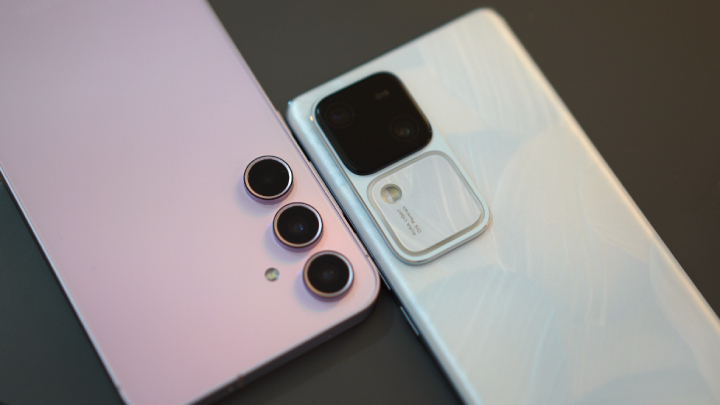
The phones we have for our netizens today are none other than the Samsung Galaxy A55 5G and the vivo V30 5G.
But apart from focusing on what’s on paper, we’ll look into our recorded benchmarks and overall experience from our reviews.
For reference, we’ve also prepared a specs table for your interests.
| Samsung Galaxy A55 5G | vivo V30 5G |
|---|---|
| 6.6-inch (2340 x 1080) FHD+ Super AMOLED display | 6.78-inch (2800 x 1260) curved AMOLED display |
| 120Hz refresh rate, HDR10+, 1000 nits (peak brightness) | 120Hz refresh rate, HDR10+, 2800 nits (peak brightness) |
| Corning Gorilla Glass Victus+ protection | Schott Alpha Glass protection |
| Samsung Exynos 1480 | Qualcomm Snapdragon 7 Gen 3 |
| Samsung Xclipse 530 GPU | Adreno 720 GPU |
| 8GB, 12GB RAM | 12GB RAM |
| 128GB, 256GB internal storage | 256GB, 512GB internal storage UFS 2.2 |
| Triple-rear cameras: • 50MP F1.8 main • 12MP F2.2 ultrawide • 5MP F2.4 macro | Dual-rear cameras: • 50MP F1.9 main • 50MP F2.0 ultrawide |
| 32MP F2.2 front camera | 50MP F2.0 front camera |
| 5G LTE | 5G LTE |
| Dual stereo speakers w/ Dolby Atmos | Mono loudspeaker, in-display call speaker |
| Dual nano-SIM/Hybrid microSD | Dual nano-SIM |
| WiFi 6 | WiFi 6 |
| Bluetooth 5.3 | Bluetooth 5.4 |
| NFC support | NFC support |
| GPS, GALILEO, GLONASS, BDS, QZSS | GPS, GALILEO, GLONASS, QZSS, BDS |
| IP67 water and dust resistance | IP54 water and dust resistance |
| USB Type-C | USB Type-C |
| One UI 6.1 (Android 14) | Funtouch OS 14 (Android 14) |
| 5,000mAh Li-Ion battery, 25W wired charging | 5,000mAh Li-ion battery, 80W FlashCharge |
| 161.1 x 77.4 x 8.2mm (dimensions) | 164.4mm x 75.1mm x 7.45mm (dimensions) |
| 213 grams (weight) | 186 grams (weight) |
| Ice Blue, Navy Blue Lilac, Lemon (colors) | Green Sea, Petals White (colors) |
With base models with only a nine peso difference in pricing, how will each device fare with one another? Let’s dive right in and see what makes these phones tick!
Table of Contents
In terms of display, the A55 and V30 aren’t too far off from each other.

The Samsung Galaxy A55 sports a 6.6-inch FHD+ Super AMOLED display (2340 x 1080) that features a refresh rate of 120Hz.
This panel also gets a peak brightness of a thousand nits and HDR10+ support. Additionally, the display also has a layer of Corning Gorilla Glass Victus+ protection.
On the other hand, the vivo V30, comes with a 6.78-inch QHD+ ‘Curved’ AMOLED display (2400 x 1080) out-of-the-box.
However, end users can bump this down to a FHD+ resolution in display settings to save on battery life.
To add, the V30 has a higher peak brightness of 2800 nits along with HDR10+ support as well. For protection, the 2K panel is covered by a layer of Schott Alpha Glass.

For audio, the Galaxy A55 has dual stereo speakers with Dolby Atmos support that can be toggled and customized through the quick access menu or Settings.
Meanwhile, the V30 has a mono speaker or single downward-firing speaker, with a subtle in-display speaker above the punch hole camera that only works when taking calls.
With our recent review of the A55, I’d have to say that the display feels great. Users can play Ultra HD videos downscaled for its FHD+ panel with no lags. And UI animations and navigating through the interface is certainly smooth.
Sure, its performance under sunlight isn’t as prominent with only a thousand nits of brightness, but it’s definitely passable for under direct sunlight usage.
In terms of sound quality, the A55 provides end users with strong bass from its dual stereo speakers. The mids also notably stand out in its overall sound stage.
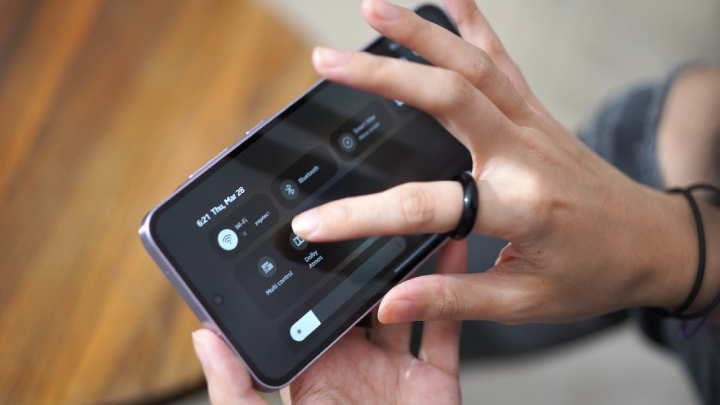
Speaking of, the A55’s audio quality only improves with Dolby Atmos enabled, providing end-users a more 3D audio experience compared to when it’s disabled.
But at the same time, the vivo V30’s display provides end users with great picture clarity, even outdoors in direct sunlight.
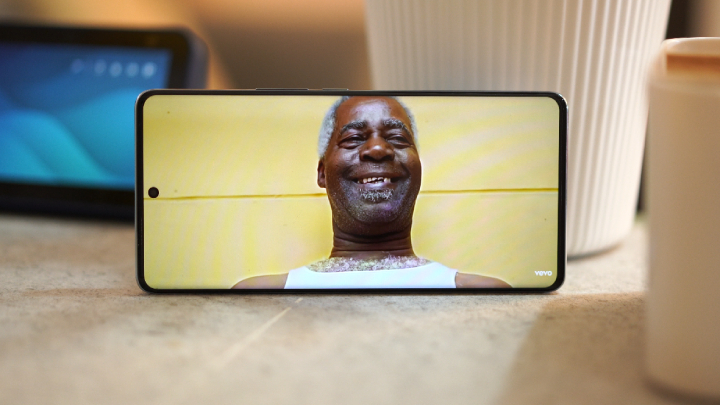
We surely enjoyed consuming video content amongst other things on the device, with no nitpicks in particular.
It’s also somewhat nicer to hold up when lying down with its thinner form factor, at a lighter 186 grams, compared to the Galaxy A55’s boxier 213 grams.
For audio capabilities, we can only say we’re content with the vivo V30’s single speaker setup.
But after a debate with fellow producers, we believe the V30 should at least have dual stereo speakers for its price. I mean, it’s loud for sure, but pales in comparison to the more immersive audio experience the A55 provides.
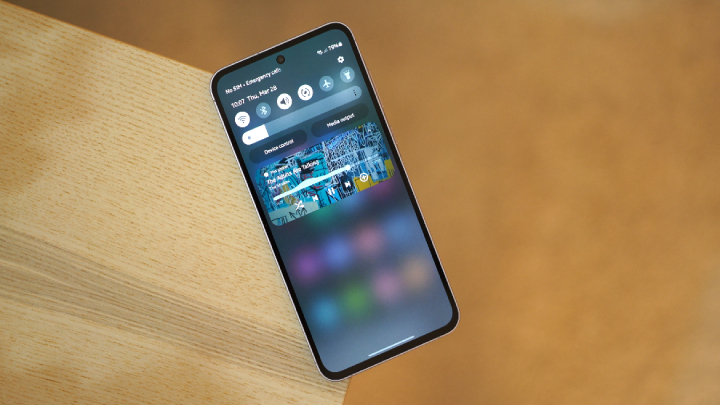
The A55 provides an above-average display, only improved with a balanced audio setup.
While we do appreciate the V30 putting a lot into its display, the complementary component in audio felt left behind.
Although it is worth mentioning, this probably won’t really be a big issue for users who mostly consume their content with a good pair of wireless headphones, earbuds, or BT speakers.
Moving on to hardware, the Galaxy A55 runs on a Samsung Exynos 1480 chipset.
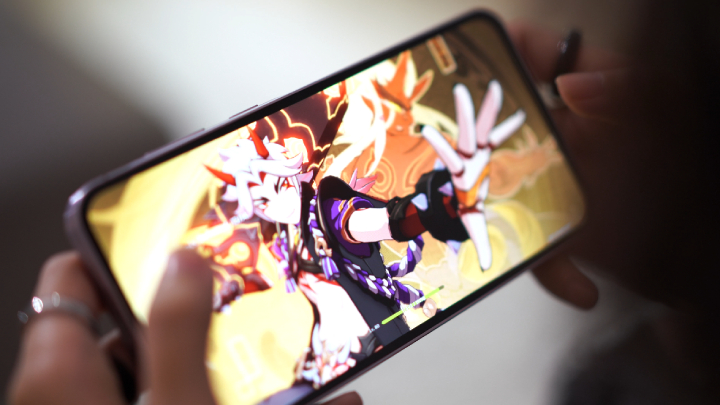
This 4nm chipset runs on four (4) Cortex-A78 cores at 2.75GHz and four (4) Cortex-A55 cores at 2.05GHz. For graphics processing, the Exynos 1480 is paired with a Xclipse 530 GPU.
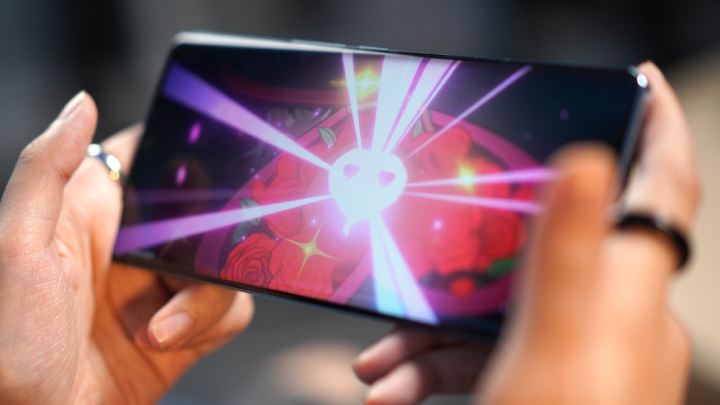
Meanwhile, the V30 runs on a Qualcomm Snapdragon 7 Gen 3.
This 4nm chipset runs on one (1) Cortex-A715 core at 2.63GHz, three (3) Cortex-A715 cores at 2.4GHz, and four (4) Cortex-A510 cores at 1.8GHz. For the V30’s GPU, the chipset is paired with an Adreno 720.
Considering both chipsets are relatively new releases, they should fare well with upkeep. However, after looking at our benchmark scores the Qualcomm Snapdragon 7 Gen 3 has the clear advantage.
For reference, we’ve prepared a table below comparing benchmark scores for both chipsets.
| Samsung Galaxy A55 5G | vivo V30 5G | |
|---|---|---|
| Chipset | Samsung Exynos 1480 | Snapdragon 7 Gen 3 |
| Benchmarks | ||
| Antutu V10 | 728,872 | 818,694 |
| Geekbench 6 Single-core | 1143 | 1142 |
| Geekbench 6 Multi-core | 3340 | 3210 |
| Geekbench 6 OpenCL | 3989 | 3555 |
| Geekbench 6 Vulkan | 4125 | 4169 |
| PCMark Work 3.0 | 13,174 | 10,773 |
| 3D Mark: Wild Life | 3800 | 5442 |
| Antutu Storage | 59,639 | 48,376 |
| Reading Score & Speed | 19,870 & 1731.7 MB/s | 11,364 & 990.3MB/s |
| Writing Score & Speed | 11,582 & 1009.3MB/s | 9914 & 864.0MB/s |
| Random Access Score | 28,187 | 27,098 |
| Memory Reading Speed | 456.0MB/s | 407.0MB/s |
| Memory Writing Speed | 310.0MB/s | 321.0MB/s |
| Chipset Release Date | March 2024 | November 2023 |
Although interestingly, the phones’ benchmark scores aren’t that far off from each other. However, there are points of contention in Antutu, 3D Mark Wild Life, and PC Mark Work 3.0.
But even with the given data, we have to consider from our review experiences that the devices more or less have equal performance in real-world usage.

Personally, we would lean more towards the Galaxy A55. This is solely because the V30 tends to heat up noticeably faster than the A55 in prolonged gaming sessions.
This could also be due to the bigger frame of the A55, which could allow for better thermals. So even if the V30 looks better on paper, we’re going with the visually smoother performing Galaxy A55.
In our opinion, Android devices need the minimum of 8GB to compete in the midrange smartphone market.
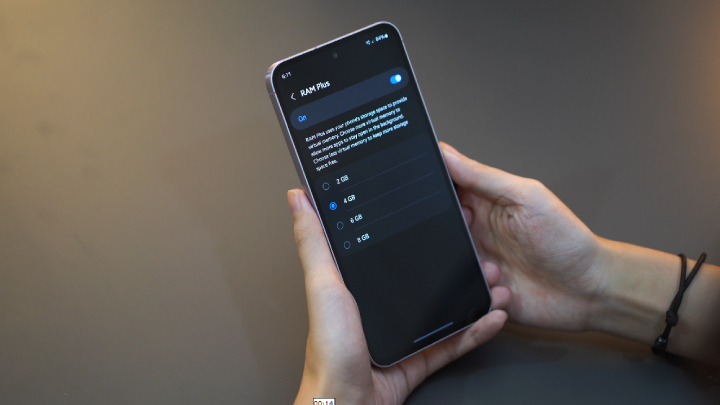
Fortunately, the A55 provides end users with this option, and a variant with 12GB available too. The Galaxy A55 5G also has up to 8GB of virtual memory to add on top of what’s on board.
With the V30 however, users are provided with a fixed 12GB.

The V30 also has a RAM extension feature that can be toggled. When turned on, it can provide users with up to an additional 12GB of virtual memory to help with multitasking.
For storage, the A55 has options for 128GB and 256GB of UFS 3.1 internal storage.
But if this feels lackluster, luckily, the device gives users the option to sacrifice the second nano-SIM slot for a microSD card to expand storage.
The V30, however, has 256GB and 512GB of UFS 2.2 internal storage available.
Clearly, both phones have the ability to smoothly handle storage for software, apps, and general data. There are also features that may come into play such as the V30’s virtual memory extension and the A55’s microSD card storage support.
However, we’ll have to refer to our previous benchmark scores in the Antutu Storage Test to reach a verdict.
The A55 has a clear advantage in reading (1731.7 MB/s) and writing (1009.3MB/s) speeds when compared to the V30 (990.3MB/s reading & 864.0MB/s writing speeds).
Additionally, the A55 also leads for random access score (28,187) and memory reading (456.0MB/s) and writing (310.0MB/s) speeds. Meanwhile, the V30 has a random access score of 27,098 with lower memory reading (407.0MB/s) and writing (321.0MB/s) speeds.

These numbers mean that the A55 is supported by a better storage setup. So even if the V30 has higher base RAM and memory, the A55 can process these quicker.
Again, we’re going to have to choose the A55 for this round. This could relate to our previous stance on the device heating up quicker in comparison.
For cameras, we have an interesting point of contention as the A55 has a triple-rear camera setup pinned against the V30’s dual-rear cameras.
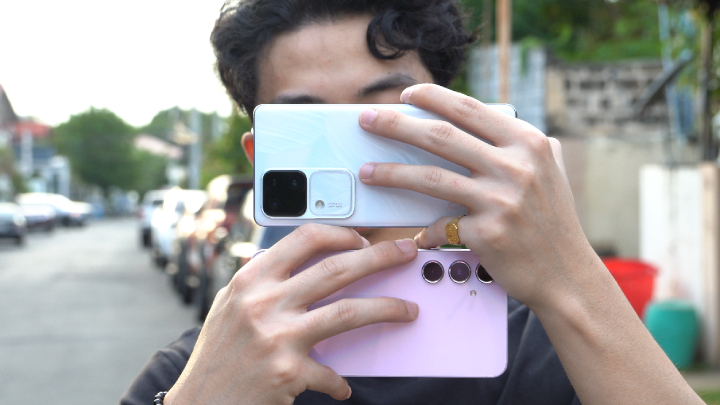
The Galaxy A55 has a 50MP (f/1.8) main camera, a 12MP (f/2.2) ultrawide, and a 5MP (f/2.4) macro lens.
In contrast, the V30 has a 50MP (f/1.9) main camera and a 50MP (f/2.0) ultrawide.
In the front, the Galaxy A55 5G sports a 32MP (f/2.2) selfie shooter, while the vivo V30 has a 50MP (f/2.0) front camera.
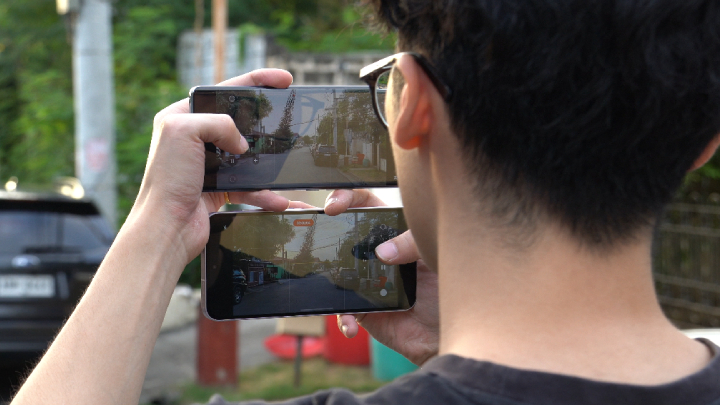
Both phones can also shoot videos at 4K at 30fps and 1080p at 30fps with gyro-EIS enabled for both rear cameras.
All things considered, personally, we’re all aware that Samsung isn’t best known for their cameras. However, the A55 did perform well enough to produce sharp photos with great detail and actually decent videos much to our surprise.
To add, one of our producers noticed that the A55’s telephoto lens doesn’t work in portrait mode. It’s a small design flaw, but noticeable when the V30 doesn’t have this issue at all. Although, this can be fixed with a software update.

As for the V30, it was literally made with this feature up front and center with its Aura Light ring as a selling point.
Speaking of, the V30’s Aura Light ring comes in handy when under unfavorable lighting conditions. It gives shooters an accessible, diffused fill light for subjects, adding some appreciated detail to photos and videos.
It just goes to show that more cameras and megapixels don’t equal a great photo. But while these surely help end users to produce more detailed images, these aren’t everything.
And in this case, having the Aura Light feature is a nice cheat code to achieve this without having to think too much about shot composition.
We’re going to have to go with the V30 for this one, as it scores its first point in this specs comparison.
Next, for connectivity and features, both smartphones have 5G support as the name implies.

The devices also have dual nano-SIMs, WiFi 6, and NFC. However, the A55 has Bluetooth 5.3, with the V30 having Bluetooth 5.4 supported.
The phones also run on OneUI 6.1 and Funtouch OS 14 based on Android 14, respectively.
For resistance ratings, the A55 has a higher IP67 rating compared to the V30’s IP54 rating against water and dust.
The call quality on both phones are both alright. Phones were initially made for this purpose, so we don’t have anything in particular to nitpick about here.

But if it were up to us, we’d have to go with the A55 again. While I appreciate what the V30 offers with Funtouch OS, the A55’s OneUI seems to look a lot easier on the eyes of our producers here in the studio.
Just like our executive producer, we’ve come to appreciate the features that come with the A55. It lets you quickly launch your camera, has Dolby Atmos, and just feels a lot more polished overall.
The higher IP rating plays into insurance for tiny everyday accidents that we never see coming.
Additionally, the A55 has four years worth of software updates and five years of security patches. As for the V30, it has three years worth of Android updates and four years of security patches.
But at the end of the day, choosing a winner based on UI preference really isn’t our thing, and the V30 does have a more updated Bluetooth version, so we can give this one to the vivo V30.
The smartphones are both powered with 5,000mAh batteries and charge via USB Type-C.

However, the devices have differences in charging technologies. The A55 features 25W quick charge, while the V30 has 80W FlashCharge support.
Charging the A55 to full takes about an hour and 30, and the V30 takes just an hour. Additionally, when charging, the A55 also shows users how much time is left to full, while the V30’s time until fully charged can be viewed under settings.
But if you want a device lasting you the whole day, the V30 is way ahead of the A55 in this area.
In fact, in PC Mark’s Work 3.0 Battery Test, our review unit lasted 24 hours and 54 minutes. As for the A55, the phone managed to pump out 13 hours and 12 minutes of activity.
But in our standard video loop test, the A55 was able to last 22 hours and 46 minutes. However, the V30 is ahead again here with a whopping 30 hours and 57 minutes.
Both tests were conducted with the devices set to airplane mode, at 50% brightness, and with volume muted to account for mixed usage variables.
But okay, remember when we mentioned that the V30 heats up quicker than we expected? The 80W of FlashCharge doesn’t necessarily help this issue.
This is a lot of power coming into a very slim phone that noticeably heats up quicker than its match-up. However, end users can hop into settings and turn on Super Battery Saver and Optimize Battery Life to mitigate this.
But even so, the V30 takes this round through its insane battery lifespan and quick charging capabilities.
Alright, it’s time for what everyone has been waiting for, how much are the devices priced for? At the beginning, I mentioned that the phones only have a difference of nine pesos in pricing for base models.

The Samsung Galaxy A55 5G is priced at PHP 24,990USD 426INR 36,101EUR 406CNY 3,101 with 8GB of RAM and 256GB of internal storage. It’s available in Ice Blue, Lilac, Lemon, and Navy Blue colorways.
The A55 variants with 128GB of internal storage will be available as options exclusive to Globe Telecom and Smart Communications users.

Meanwhile, the vivo V30 5G is priced at PHP 24,999USD 426INR 36,114EUR 406CNY 3,102 with 12GB of RAM and 256GB of internal storage. It’s also available with 12GB of RAM and 512GB of internal storage for PHP 27USD 0.46INR 39EUR 0.44CNY 3,999 with available colors in Petals White and Green Sea.
The devices are competitively priced and are insanely good matches against each other on paper. However, we would highly suggest readers to look into the Galaxy A55.

The Galaxy A55 has an exceptional display, good performance courtesy of its chipset, and great features playing into its minimalist design language. If you’re interested, you can go ahead and read our Samsung Galaxy A55 5G Review 98.
But even so, the vivo V30 is still a solid asset for end users. It has a superb camera setup, insane battery life, and surprisingly good overall performance. If you’re curious on what else the device can do, feel free to read our vivo V30 5G Review 45.
What do you guys think of the Samsung Galaxy A55 5G and the vivo V30 5G? Let us know in the comments below!

YugaTech.com is the largest and longest-running technology site in the Philippines. Originally established in October 2002, the site was transformed into a full-fledged technology platform in 2005.
How to transfer, withdraw money from PayPal to GCash
Prices of Starlink satellite in the Philippines
Install Google GBox to Huawei smartphones
Pag-IBIG MP2 online application
How to check PhilHealth contributions online
How to find your SIM card serial number
Globe, PLDT, Converge, Sky: Unli fiber internet plans compared
10 biggest games in the Google Play Store
LTO periodic medical exam for 10-year licenses
Netflix codes to unlock hidden TV shows, movies
Apple, Asus, Cherry Mobile, Huawei, LG, Nokia, Oppo, Samsung, Sony, Vivo, Xiaomi, Lenovo, Infinix Mobile, Pocophone, Honor, iPhone, OnePlus, Tecno, Realme, HTC, Gionee, Kata, IQ00, Redmi, Razer, CloudFone, Motorola, Panasonic, TCL, Wiko
Best Android smartphones between PHP 20,000 - 25,000
Smartphones under PHP 10,000 in the Philippines
Smartphones under PHP 12K Philippines
Best smartphones for kids under PHP 7,000
Smartphones under PHP 15,000 in the Philippines
Best Android smartphones between PHP 15,000 - 20,000
Smartphones under PHP 20,000 in the Philippines
Most affordable 5G phones in the Philippines under PHP 20K
5G smartphones in the Philippines under PHP 16K
Smartphone pricelist Philippines 2024
Smartphone pricelist Philippines 2023
Smartphone pricelist Philippines 2022
Smartphone pricelist Philippines 2021
Smartphone pricelist Philippines 2020
Art Garcia says:
the A55 has microSD support, esim support, 4 years of OS upgrades, and better IP rating. so yeah, A55 for the win.